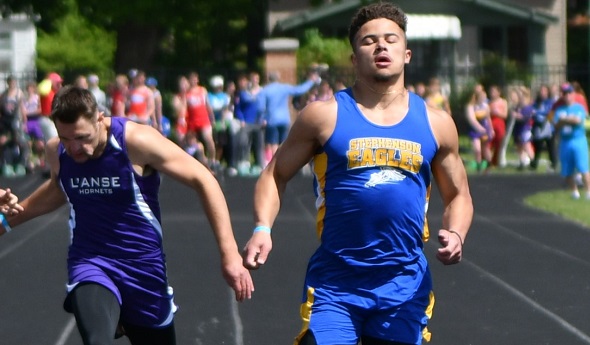
Preview: Don't Miss This Grand Finale
May 31, 2019
By Geoff Kimmerly
Second Half editor
Pick a division – any of seven Saturday – and you’re bound to find a senior standout finishing his career at the MHSAA Boys Track & Field Finals.
Michigan high schools regularly graduate star-loaded classes in this sport – but with reigning champions headlining lineups all over the Lower and Upper Peninsula this weekend, this grand finale guarantees to be memorable.
Below is a look at some of the teams and individuals to watch at Saturday’s boys meets. All events begin at 9 a.m. local time on both peninsulas.
Click for meet information including all qualifiers. Check out MHSAA.tv for live streaming of running events from both peninsulas, available with subscription and beginning at 10 a.m., and come back Saturday night for results as they come in and coverage of all seven meets on Second Half.
LP Division 1 at East Kentwood
Top Regional team scores: 1. Grosse Pointe South 142, 2. East Kentwood 139.5, 3. Alpena 130, 4. Plymouth 125, 5. Macomb Dakota 114.
Team forecast: East Kentwood has won the last two LPD1 championships and seven of the last 10. The Falcons look like significant favorites again with the fastest Regional times in the 400, 800 and 1,600 relays, top-five times in five individual races and contenders in at least three field events.
Detroit Renaissance’s Dylan Brown: The junior sprinter ran the top Regional time in the 200 (21.69) and second-fastest in the 100 (10.75) and also runs on two contending relays. He was part of the winning 800 relay and finished fifth in the 200 last season for Detroit Martin Luther King.
Ann Arbor Pioneer’s Nick Foster: The senior distance standout is looking to add to last season’s championships in the 3,200 and as part of the 3,200 relay. His 9:16.60 in the 3,200 was the third fastest in LPD1 Regionals this spring, and he ran the fastest 1,600 (4:12.87).
Lansing Waverly’s Keshaun Harris: The reigning 300 hurdles champion is seeking to sweep those races after finishing a close second as well in the 110 race last spring. He had the fastest LPD1 Regional time in the 110 (14.23) and sixth-fastest in the 300 (38.71).
Rockford’s Noah Stallworth: After coming in fifth in the 100 and eighth in the 200 as a junior, Stallworth had the fastest 100 (10.54) and second-fastest 200 (21.79) at LPD1 Regionals and runs on 400 and 1,600 relays that both were the third fastest in qualifying. He was part of the 400 relay champion in 2017.
LP Division 2 at Zeeland
Top Regional team scores: 1. Dearborn Divine Child 193, 2. Zeeland West 157, 3. Corunna 139.67, 4. Parma Western 130, 5. Yale 118.
Team forecast: The LPD2 Finals have seen 15 schools win the championship at least once over the last 16 seasons. Zeeland West might the favorite this time, after also winning in 2014, with big scoring possible in the hurdles, middle and distance races, long jump and at least three relays.
Otsego’s Alex Comerford: Last season’s 3,200 champ will look to finish his high school career with a pair of titles after running the second-fastest LPD2 Regional time in that race (9:25.94) and fastest in the 1,600 (4:18.41) – although he faces strong competition in Corunna senior Ben Jacobs and East Grand Rapids junior Evan Bishop.
Tecumseh’s Jacob Denison: The 400 winner last season as a junior had the sixth-fastest LPD2 Regional time in that race (50.25) but the second-fastest in the 200 (22.29) and also runs on an 800 relay that should contend.
Saginaw’s Tony Martin: The reigning long jump champion went over 26 feet during a regular-season meet, which would break the all-Finals record by two feet. He won his Regional at 21-10.25, the second-best jump in LPD2 Regional competition behind the 22-3.5 of Hudsonville Unity Christian junior Isaac TeSlaa.
Coldwater’s Dylan Targgart: Coming off a sweep of the throws last season as a sophomore, Targgart had the best tosses in both the shot put (61 feet) and discus (166-8) at LPD2 Regionals. He should make a run at the LPD2 Finals shot put record of 61-8 set by Ogemaw Heights’ Anthony Zettel in 2011.
LP Division 3 at Jenison
Top Regional team scores: 1. Berrien Springs 174.5, 2. Warren Michigan Collegiate 161, 3. Caro 148, 4. Adrian Madison 139.5, 5. Madison Heights Bishop Foley 134.
Team forecast: Similar to LPD2, this division has seen nine schools take turns winning the last nine championships (although three schools have come in second at least twice during that time). Berrien Springs was the runner-up a year ago and should put up some points – but keep an eye out for Pewamo-Westphalia and Saugatuck. P-W should contend in the throws, sprints, middle distance and at least two relays, while Saugatuck – the Division 4 champion or co-champion three of the last six seasons – has the favorites in both distance and hurdles races.
Saugatuck’s Brad Dunn: After taking third in the 110 and fifth in the 300 hurdles last season, Dunn had the top LPD3 Regional times in both this spring as a senior at 14.66 and 40.18 seconds, respectively.
Saugatuck’s Corey Gorgas: After sweeping the 1,600 and 3,200 last season as a junior, Gorgas is favored to do so with the top LPD3 Regional times of 4:19.24 and 9:43.98, respectively – although 800 favorite Jeremey Kloss from Harbor Springs should be right there with him in the 1,600, as should Caro star Yami Albrecht.
Grandville Calvin Christian’s Caleb Schutte: The senior sprinter won the 100 last year and was on the winning 400 relay as a sophomore. He enters this weekend with the second-fastest LPD3 Regional time in the 100 at 11.01 and the fastest in the 200 at 22.24.
Berrien Springs’ Sam Spaulding: The reigning high jump champ won his Regional at 6-2, which ties him for fifth among all LPD3 Regional performances. He’s gone 6-5 this senior season, which would put him one inch shy of the best qualifying mark.
Kent City’s Giovanni Weeks: Another reigning champion looking to go out on top is Weeks, who won the 200 last season and finished just behind Schutte in that race (22.34) and also in the 100 (11.08) at the Regional. His winning Regional long jump of 21-3.5 was fourth in the division for all Regionals.
LP Division 4 at Hudsonville Baldwin Middle School
Top Regional team scores: 1. Lutheran Westland 172, 2. Southfield Christian 158, 3. Addison 155.25, 4. Maple City Glen Lake 138, 5. Kalamazoo Hackett 135.
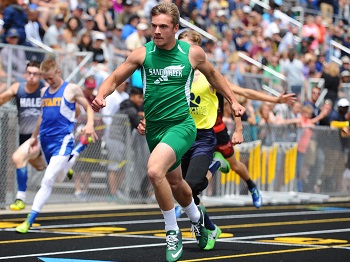 Team forecast: Hackett won its first MHSAA Finals championship in this sport last season, and Addison could become a first-time champ with at least one competitor in all but one race and three of five field events. Hillsdale Academy could be that team this weekend too with favorites in at least three events and a solid contender in a fourth. Breckenridge is another possible first-time champion with the possibility of earning big points in the throws, distance races and sprint relays.
Team forecast: Hackett won its first MHSAA Finals championship in this sport last season, and Addison could become a first-time champ with at least one competitor in all but one race and three of five field events. Hillsdale Academy could be that team this weekend too with favorites in at least three events and a solid contender in a fourth. Breckenridge is another possible first-time champion with the possibility of earning big points in the throws, distance races and sprint relays.
Kalamazoo Hackett’s Heath Baldwin: After winning the 110 hurdles and long jump last year, Baldwin will make a run at four championships in his last high school meet. He had the second-fastest LPD4 Regional times in the 110 (15.06) and 300 hurdles (40.63), tied for the fourth-highest high jump (6-3) and also won his long jump at 20-0.5.
Hale’s Patrick Harris: The champion in the 400 the last two years just missed qualifying in that race but will cap his high school career running the 200 and on a relay.
Sand Creek’s Alec Muck: The senior sprinter is one of the biggest stars competing, regardless of division, as he looks to add to his five championships including with a fourth straight in the 200. His 200 Regional time (22.85) came in fourth overall for LPD4 and his 100 time of 11.04 ranks second as he looks to win that title for the third straight season. He’s also part of the fastest 400 relay (44.44) coming off LPD4 Regional competition.
Carson City-Crystal’s Daniel Smith: The reigning shot put champ had the second-longest toss during LPD4 Regionals at 51-11.25, but again must contend with another senior, Breckenridge’s Brennan Waslusky (54-9.5) after finishing second to him at that meet two weeks ago.
UP Division 1 at Kingsford
Top Regional team scores: 1. Gladstone 79.5, 2. Ishpeming Westwood 56, 3. Marquette 55.5.
Team forecast: Gladstone will attempt to break Marquette’s four-year hold on Upper Peninsula Division 1 after coming in third a year ago. The Braves had 10 event champions at their Regional to Marquette’s four in the same meet.
Gladstone’s Adam Bruce: The 3,200 champion in 2017 as a sophomore, Bruce will try to finish his senior season with a distance sweep after posting the fastest 1,600 (4:40.73) and second-fastest 3,200 (10:29.38) at UPD1 Regionals.
Marquette’s Raphael Millado: The senior standout won both the long and high jumps last season and enters with the best UPD1 Regional showings in both at 19-11 and 6-2, respectively. He also had the fourth-fastest 200 qualifying time (24.12).
Escanaba’s Dayton Miron: The reigning pole vault champion enters this weekend’s meet tied with the second-highest vault at a UPD1 Regional (11-0), and he’ll also cap his junior season running on three relays.
Gladstone’s Calvin Thibault: The sophomore sprinter/hurdler could end up the star of this meet. He won the 110 and 300 hurdles last season and had the fastest UPD1 Regional times in those races two weeks ago at 15.40 and 41.25, respectively. He also paced the UPD1 qualifiers in the 100 (11.49) and 200 (23.64).
UP Division 2 at Kingsford
Top Regional team scores: 1. Newberry 74, 2. Ishpeming 65, 3. Norway 52.5.
Team forecast: Ishpeming is the reigning champion and has won four of the last five UPD2 titles, with Newberry defeating the runner-up Hematites to claim the championship in 2017. They competed in and won separate Regionals two weeks ago, but on paper Newberry appears to have the upper hand.
Manistique’s Schyler Andersen: The junior standout will make a run at four individual titles with the fastest UPD2 Regional time in the 400 (52.61), top discus throw (140-10), second-best shot put (43-0) and second-fastest 200 (23.70). His best at the 2018 Finals was a fourth place in shot put.
Gwinn’s David Duvall: After taking eighth in the 110 hurdles a year ago as a freshman, Duvall could make a big jump entering this weekend with the top UPD2 Regional times in the 100 (17.72) and 300 (45.35) and the second-best long jump (17-7.5).
Newberry’s Jaylen James: He’s ready to lead Newberry’s team title hunt after helping two relay champs a year ago. He enters with the best UPD2 Regional long jump (18-10), 100 (tie – 11.49), 200 (23.15) and running on the favored 800 relay (1:38.53).
Manistique’s Alex Misniakiewicz: The junior got close last season with two second places and a third in individual events. He enters this weekend as the top qualifier in the 800 (2:10.51), 1,600 (4:44.94) and second-best in the 3,200 (10:49.24).
UP Division 3 at Kingsford
Top Regional team scores: 1. Rapid River 105, 2. Bessemer 86, 3. Brimley 72.5.
Team forecast: Bessemer last season won its first championship in this sport since 1951 and should be in the mix again with the top performers from all UPD3 Regionals combined in nine events. Rapid River was the runner-up in 2018 after two straight titles in 2016 and 2017.
Bessemer’s Uriah Aili: The reigning champion in the 3,200 will make a run at winning at least three races as a senior with the top UPD3 Regional times in the 800 (2:02.41) and 3,200 (10:09.5) and second-fastest in the 1,600 (4:44.49). He also qualified in discus (103-3).
Cedarville’s Thomas Bohn: His 4:33.24 a year ago is the meet record, and he’s ahead of Aili in that race coming into this weekend at 4:43.81. Bohn, a junior, also will run the 3,200 (11:01.82) and 800 (2:07.84).
Bessemer’s Tyler Busch: The reigning shot put champion will look to repeat as a senior, entering with the best toss from UPD3 Regionals at 46-6.
Stephenson’s Montel Glover: The top UPD3 Regional performer in the 100 (11.30), 200 (23.85) and 400 (51.39) won all three of those races in UPD2 the last two seasons, and he’ll also run on a 1,600 relay with a chance at a title.
Bessemer’s Jamie Jett: He’ll look to add to his 2018 110 hurdles and 800 relay championships as a junior, entering this weekend with the top UPD3 Regional times in the 110 (16.76) and 300 (44.11). He’s also running the 200 (24.60) and competing in long jump (18-1.5).
PHOTOS: (Top) Stephenson’s Montel Glover, right, finishes just ahead of L’Anse’s Foster Miller in the 200 at last season’s UP Division 2 Finals. (Middle) Sand Creek’s Alec Muck powers through for one of his sprint championships in LP Division 4 last spring. (Click to see more from RunMichigan.com.)
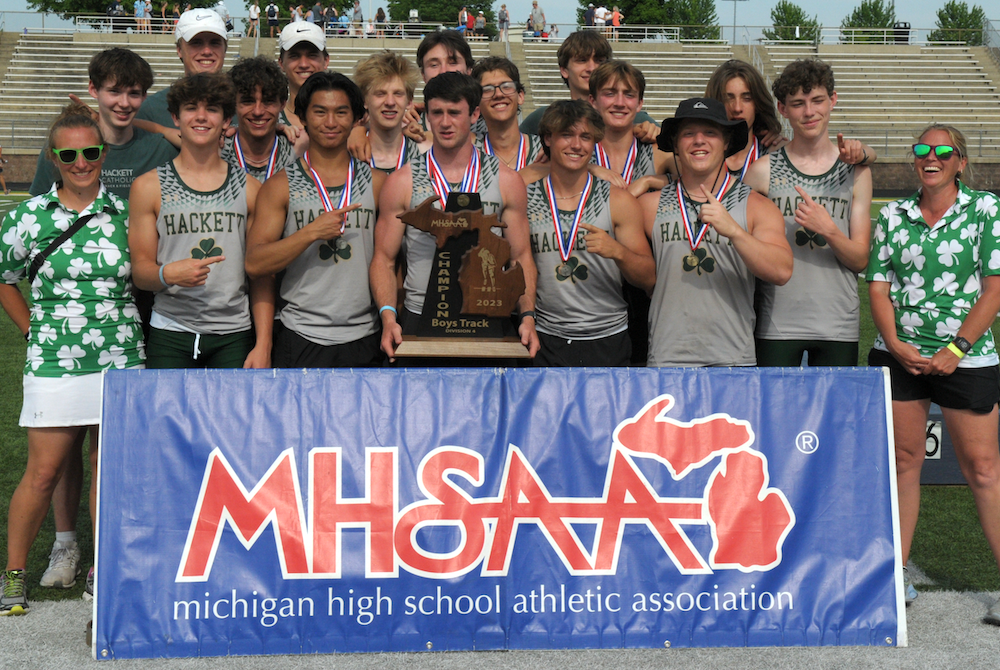
Thrower Claims Lone Individual Title to Lead Hackett to Team 3-Peat
By
Tom Lang
Special for MHSAA.com
June 3, 2023
Kalamazoo Hackett Catholic Prep just keeps winning and winning.
This time the Irish took home their fourth title in the last five Lower Peninsula Division 4 Track & Field Finals, on Saturday at Hudsonville.
Hackett’s only individual title was taken by discus winner Nathan Buchmann, a senior, who was fine knowing he was the shortest in stature among all the sizable competitors.
“In the offseason after football I worked out every day, working towards this goal,” he said after getting his medal. “I would say this takes 80 percent technique and 20 percent strength to throw the discus. So, length can help but if you have good technique and are really strong, that will play into it.
“I think we are very balanced throughout the meet today,” he said about teammates that scored points in finishes other than first place. “We have 13 guys here today, and we have people in a lot of the races. But I do not run; I have too short of legs to be a fast runner,” he said with a chuckle.
Buchmann had to work through a hip injury to compete this spring.
“I think the setbacks are what make you strong,” he said. “You can either give up through the setbacks or push forward and become better.”
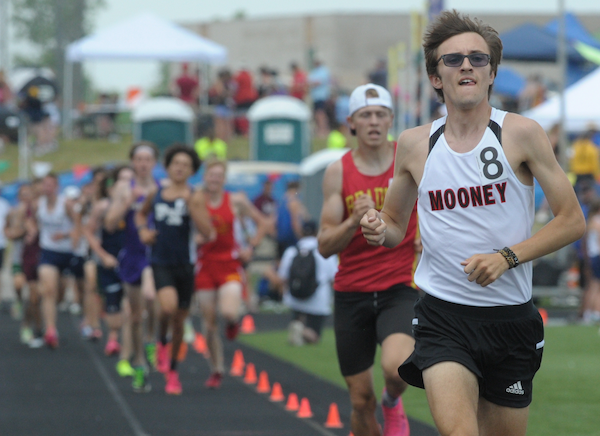 Coach Charissa Dean agreed.
Coach Charissa Dean agreed.
“The kids have big hearts,” she said after all the points were totaled and the Irish were on top once again, with 53. “They worked hard. They had a lot of potential when we started the season. And we had a lot of drive to put in the work, and we are happy the results came out the way they did.”
Reading was runner-up at 47 points, followed by Wyoming Potter’s House Christian with 42, then Fowler and Flint Beecher each with 37 points.
Senior Lezawe “Moses” Osterink, of Potter’s House Christian, placed second in 1,600 but took the 3,200 title as defending champ of both. He dominated the latter by lapping the field with a final lap kick that resembled more of a superhero speedster.
“Nobody really took it out that hard at the start,” he said. “There was a freshman (Marek Butkiewicz of Hackett) that tried to get the pace going quick, but me and Dakota (Dykhuis of Montabella) just kind of sat back and gradually pulled him through.
“We took it gradually, and I was just relying that I could kick.”
Kick did he ever. The trio were neck and neck the majority of the race in a grouping ahead of the pack.
“With 400 to go I just tried to go all out,” Osterink said. “I had a lot more left than I thought and I was pleased with the win. Not really the time, but that doesn’t matter, especially this hot out.”
The overall meet was in the low 90s/high 80s heat and searing sun all day. So, race officials allowed the unique opportunity for coaches to spray the runners with water and give them water bottles.
“It was very weird because I’ve never taken water to drink while I’m running, so I didn’t know how that would feel,” Osterink said. “And they were spraying us and hitting us in the face. It was kind of fun.”
Junior Tyler Lenn of Marine City Cardinal Mooney defeated Osterink at his own game in the 1,600.
“I’m feeling great,” Lenn said after grabbing the medal. “I said to a newspaper after one of my races (during the season) I was right where I wanted to be. This has been a long rebuilding process for me since an injury back in the fall, and I set a pretty high goal the day the injury happened. I was telling myself I needed to fulfill what I said I would do at the beginning of last cross country season. And that is what I did today.”
Lenn suffered an ankle sprain from a misstep that turned worse because he kept running through the season on it.
“Coming back from that was pretty tough, but I wouldn’t have it any other way,” he said. 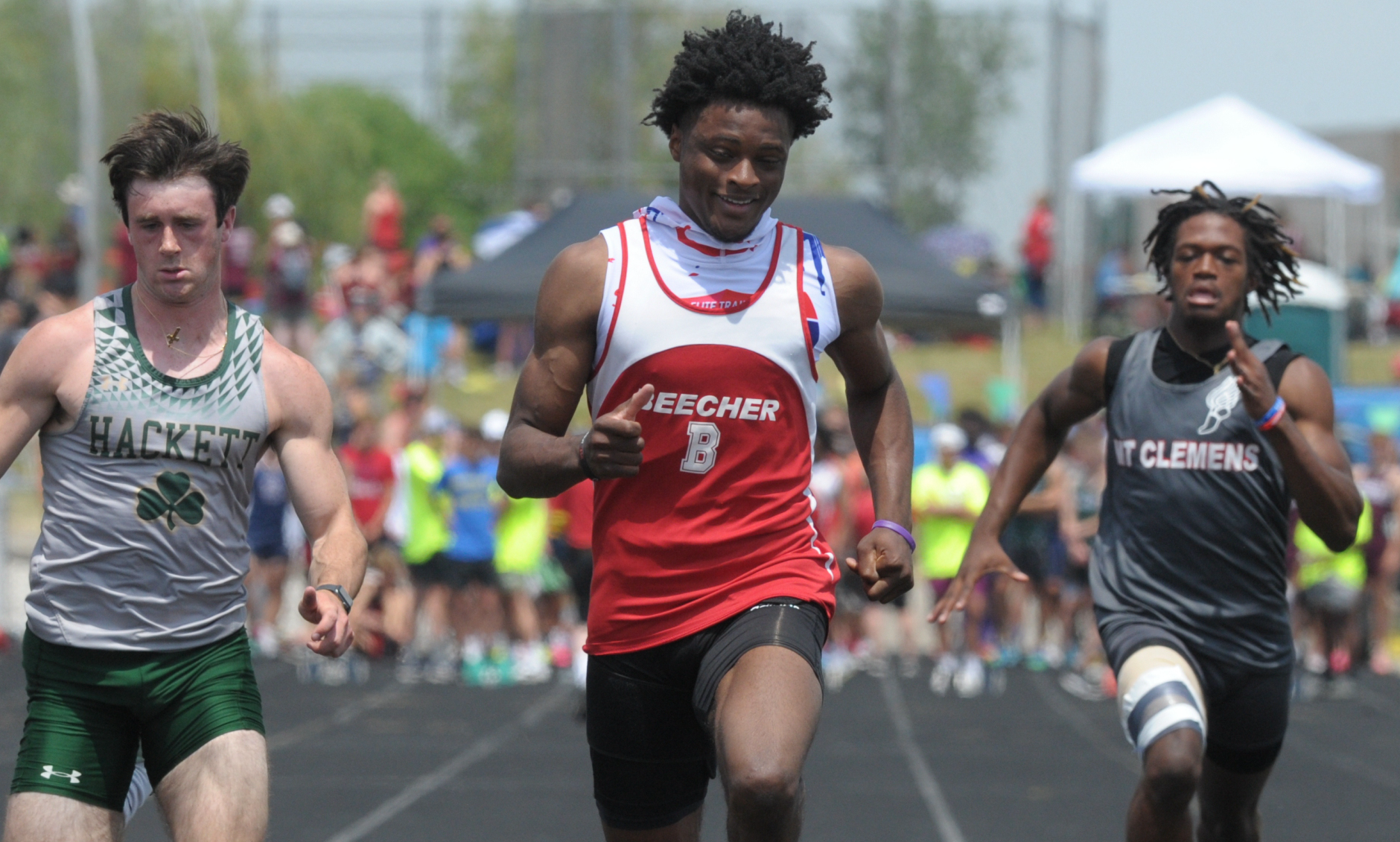 “Perseverance; I said from the beginning what I was going to do. I kept my eye on that target, and no matter the circumstances life threw at me, that I was going to make it happen and I am a man of my word.”
“Perseverance; I said from the beginning what I was going to do. I kept my eye on that target, and no matter the circumstances life threw at me, that I was going to make it happen and I am a man of my word.”
Jaylin Townsend, a senior from Flint Beecher, dominated the short races. He won the 100 dash (10.67) and 200 dash at 22 seconds flat. It was his third 100 win at a Finals.
“I put in a lot of work; I had to three-peat,” he said after the 100. “There’s a lot of great competition here, so I knew I had to come out and run my best.”
Concord in the 400 (43.72), Buckley in the 800 (1:30.76) and 1,600 (3:29.13) and Potter’s House in the 3,200 (8:14.18) were relay champs Saturday. Reading’s Tayshawn Bester won the 110 hurdles (15.13), and Athens’ Landen Bennett won the 300 (39.85). Caseville’s Nathan Feltner won the 400 (50.76), and Vestaburg’s Owen Patton claimed the 800 (1:55.11).
Fruitport Calvary Christian’s Bradley Richards won the high jump (6-10), and Peck’s Alex Affer won the long jump (23-4). McBain Northern Michigan Christian’s Isaac Bowden was first in pole vault (13-0), and Brown City’s Kyle Affer won shot put (49-2).
PHOTOS (Top) Kalamazoo Hackett Catholic Prep celebrates its third-straight LPD4 title Saturday. (Middle) Cardinal Mooney's Tyler Lenn, far right, sets the pace in the 1,600. (Below) Flint Beecher's Jaylin Townsend, middle, crosses the finish first for one of his two sprint championships. (Photos by Ken Swart/RunMichigan.com.)

